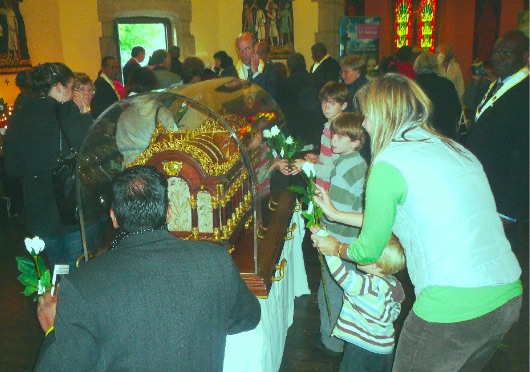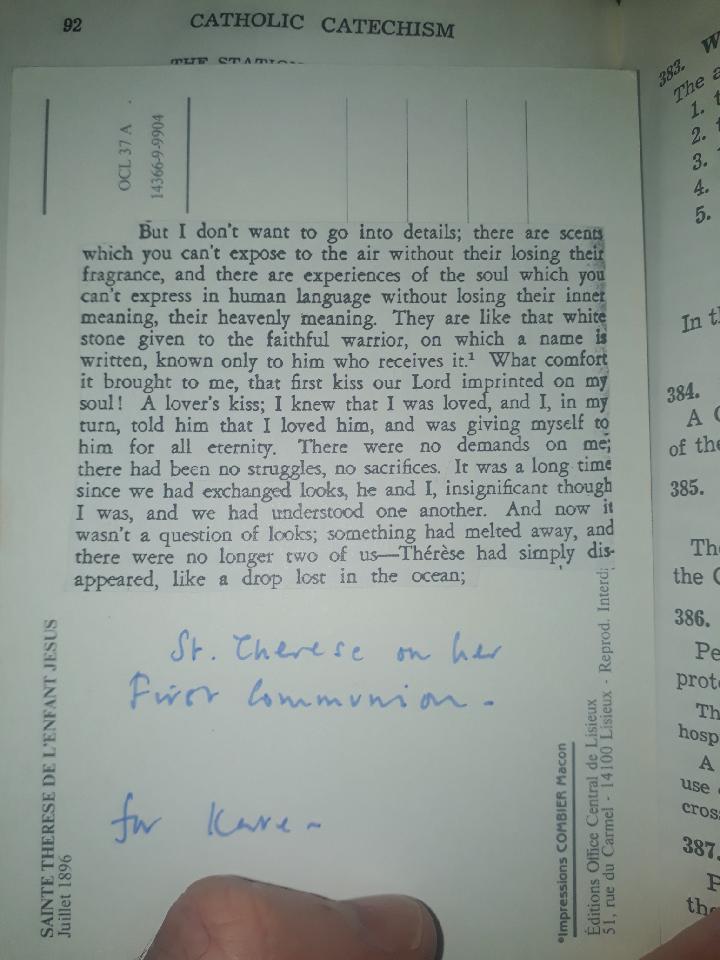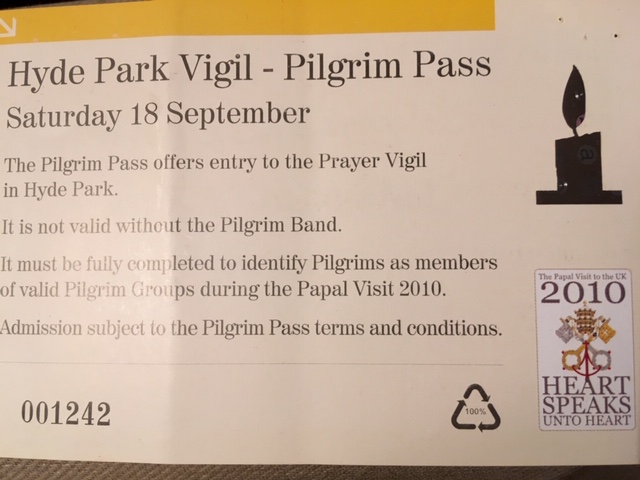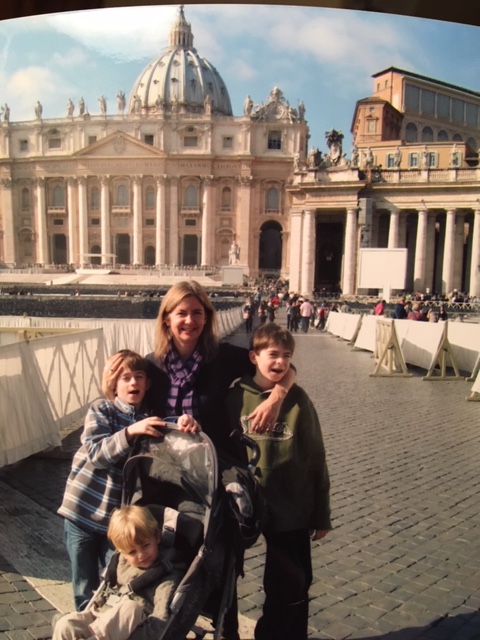Converted by the Blessed Sacrament, With the Help of St. Thérèse
How an English lawyer became Catholic after adoration with Pope Benedict XVI.

During Pope Benedict’s 2010 visit to Britain, an open-air Benediction of the Blessed Sacrament took place at London’s Hyde Park. As the Pope lifted the monstrance, and 80,000 people knelt in adoration of the Holy Eucharist, all London seemed to fall silent.
One woman, Kate Paulson, watched as the Vicar of Christ held aloft the monstrance, blessing London and the world with the Body, Blood, Soul and Divinity of Christ.
That moment was to change her life forever.
Kate had felt drawn to the Catholic Church for a number of years. And yet, despite two attempts at instruction, she had not been able to move from devout Anglicanism to Catholicism. All of that changed in an unexpected way during that unforgettable night with Pope Benedict XVI and a still more mysterious encounter with the relics of a saint.
In the fall of 2009 the relics of St. Thérèse of Lisieux were touring England. They arrived at the Marian shrine of Aylesford Priory at the end of October. On an unusually hot day, amongst the crowds arriving to venerate the relics was the Paulson family.
Kate Paulson and her husband, Graham, both lawyers, and their three boys, ranging in age from 2 to 10, decided to make the pilgrimage. Kate was reluctant to do so. She told the Register this Aug. 25 of that fateful day a decade ago, “[It was] Graham’s idea and not really the way I wanted to spend a Saturday with three small children” — the drive there and back from the Paulson home in Surrey would take at least four hours. When they arrived at Aylesford Priory, Kate’s fears materialized: “The queues were awful, and it was a really hot day. We were potty-training Georgie, and he had worked his way through all the spare changes of clothes before we had even gotten into the queue. We must have queued for at least three hours, if not more. I felt like giving up, but somehow knew we had to get to the end and come before the relics.”
When, finally, the family entered the church, there before them was a small casket holding the relics of the Carmelite saint. Whatever the older boys’ expectations, it was not this: The object of the hours of waiting appeared an anticlimax. As Kate recalled, “The queue really moved quickly for the last bit by the relics. There was so little time, but I did feel overwhelmed for a split second as I grabbed the boys’ hands and pushed them onto the glass.”

A stranger had watched all that had taken place and seen how patiently Kate had dealt with the boys. Touching Kate on the arm, he said: “Madam, you and your boys will receive many blessings for queuing for as long as you have done today.” Kate was moved by what he said and felt oddly “sure that he was right.”
Although Kate was Anglican, she had been married in the Catholic Church, as Graham was a cradle Catholic. She remembers being even more anxious than Graham that the Catholic priest who had prepared them for marriage, Father Seamus Cunnane, was there at the wedding Mass. “I remember during the service being acutely aware that Father Cunnane seemed to be the presence of God at our wedding. He was such a holy man. I was impressed by him. I could tell my Protestant family were, too. He had the full force and authority of the Catholic Church in a way that a Protestant vicar just did not.”
Kate had agreed that any children born to the couple would be brought up Catholic. In due course, three sons arrived and were baptized Catholic. In fact, after marriage, it was rare for Kate to miss Sunday Mass, even if “much of the time I felt left out and alienated, as I could not take part in Communion.”
She says now, “If I am honest, I felt a bit like an outcast. I felt cross at Catholicism a lot of the time. It was to me a bit of an exclusive club, and I was not a paid-up member. I felt humiliated kneeling and found all the ‘stand up; sit down’ bit never-ending.” But one faith element made a distinct impression on Kate. “Behold the Lamb of God”: These words of Scripture had a powerful impression on Kate, who only while at college really became a Christian. “I suppose I became aware of Catholicism at university. I remember asking my neighbor in college about being a Catholic and asking him how the Hail Mary went. He wrote out the prayer and posted it under my door one night. I remember being touched and keeping the prayer. I always seemed from then on to be drawn to Catholics for some reason. I ended up marrying one, and it became important to both of us that we had a Catholic wedding.”
Her attraction to Catholicism was to involve Kate trying, on two occasions, to become Catholic. Looking back, she has mixed feelings about the instruction she received: “My initial instruction ended badly,” she said. “I ended up getting frustrated and cross at being taken, for two hours at a time, through the Baltimore Catechism.” In the end, she wrote to the priest, thanking him for his time but saying that she was “not ready.” A second attempt at instruction followed. “A couple of years later I joined a more mainstream program, and whilst I found the program well-written and the priests kind and well-informed, we moved [from London to Surrey] and I felt no compulsion to convert or see the program through.”
On Feb. 19, 2009, then-Prime Minister Gordon Brown invited Pope Benedict XVI to visit Britain. The date of the announcement was two days before the anniversary of the birth of Cardinal John Henry Newman, and the Pope’s visit was to proclaim the former Anglican a “Blessed.” He will become a saint Oct. 13.
In the fall of 2010, Pope Benedict arrived in Britain. One of the events of the papal visit was held on Sept. 18 in London’s Hyde Park. Kate felt no compulsion to attend but today laughs, looking back at her motivation for going: “Peer pressure! The parish was going. Graham insisted. I was reluctant to go: It was not my idea of fun to spend Saturday with 80,000 people and three small children in Hyde Park!”
The family caught a London-bound train and then made their way to the city’s most famous park for Benediction at which the Pope was to preside. They waited and then watched the huge television screens in the park as, past rows of sneering protesters, the Pope traveled, serenely blessing all.
Then Benedict arrived and the Vicar of Christ held aloft the monstrance, blessing all gathered, London and the world with the Body, Blood, Soul and Divinity of Christ.
Kate can still remember that moment vividly: “I found it hard to see Pope Benedict in the distance but do remember him holding up the monstrance. It was then I asked myself: Why am I not a Catholic? The hymn Tell Out My Soul — a version of Mary’s Magnificat — “was being sung, and at the line ‘Proud hearts and stubborn wills will be set free,’ I felt something lift from my shoulders and flee. I knew that was it: I had to become a Catholic.”
The next morning Kate was “literally banging on the priest’s door demanding to become a Catholic,” explaining her desire “to a delighted but slightly bemused priest. I told him I wanted ‘fast-track conversion.’ I could not wait a single week or go through instruction: I was ready.”
She explained, “I convinced him that I had paid my dues and that the two previous courses, plus 10 years attending Mass on Sundays, were instruction enough. I literally was begging him not to make me wait. I could not become a Catholic quickly enough. I was adamant that I couldn’t wait until Easter; I literally couldn’t wait any longer.”
Shortly after this conversation, Kate wrote to Father Cunnane, the priest who had officiated at her wedding, to tell him of what had happened during the Pope’s visit and also to tell him how he, Father Cunnane, had been instrumental in her journey into the Church, too. The priest replied, telling Kate he had been standing beside Benedict at Hyde Park. The next month, on the night before Kate was received into the Church, something curious occurred. She had been intending to prepare for her first confession when a relative called with news of a family bereavement. As a result, Kate went to bed still unprepared for her confession. That night there was a terrific storm. “The clap of thunder was without warning; it was directly above the house. I have never heard thunder that near or so loud. All three children woke up and came straight into our bedroom — it was so loud.”
The unusual weather made her think, “God was saying that I had to take what I was about to do seriously.” So, at 5am, she went downstairs to prepare for her confession.
Kate went looking for her copy of the Catechism, “which I knew listed the differences between mortal and venial sins.” Finally, she found it. As she opened it at the page detailing the different types of sin, a card fell out just as there was a huge crack of thunder. Then, as the whole room was lit up, the lightening revealed the face of St. Thérèse of Liseux staring back at her.
This card was the gift of a friend, given some years before when Kate had had doubts and questions about the Eucharist.
On one side there was a picture of the Little Flower; written on the back were the saint’s words on her own first Holy Communion. The future saint wrote:
“I don’t want to go into details; there are scents which you can’t expose to the air without losing their fragrance, and there are experiences of the soul which you can’t express in human language without losing their inner meaning, their heavenly meaning.”

It was then that Kate remembered the words spoken to her the previous fall when she had venerated that saint’s relics: “You will receive great graces.”
At that point a thought struck her: Glancing up at the calendar, she realized that the date that had been fixed for her reception into the Church was one year to the day after her pilgrimage to venerate St. Thérèse’s relics. “I cried: It was such a sign to me that the postcard of St. Thérèse, which I had been searching for since deciding to become Catholic, was on that page. It was so striking. I was so aware of the presence of God. He was telling me that this was no coincidence: He was telling me I was doing the right thing.”
Now, looking back on that day, Kate said, “When I finally took Communion, I was overjoyed. My overwhelming emotion was relief! It was an end to a long journey and the beginning of a new one. I was finally in union with the rest of my family. I was a fully paid-up member of the Church, no longer an outsider, but a proper Catholic.”
K.V. Turley writes from London.



















